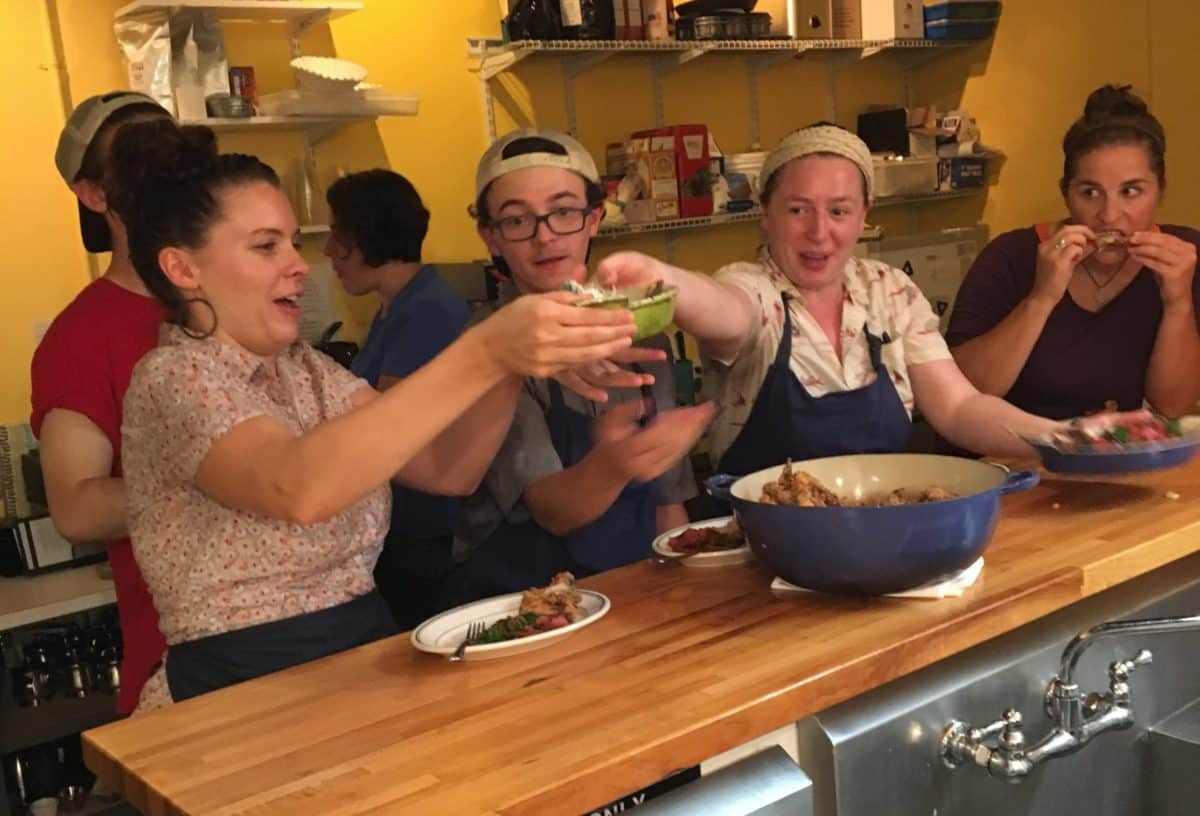Family meal. The term might conjure images of families gathered around dining tables in cozy homes. But within the bustling world of restaurants, “family meal” carries a different, yet equally vital, meaning. It’s the pre-service or post-service meal shared by the entire restaurant staff, from the head chef to the dishwasher. For many in the culinary industry, especially those of us who have spent years in the kitchen, family meal is more than just sustenance; it’s the heartbeat of the restaurant, fostering camaraderie, learning, and a sense of belonging amidst the high-pressure environment.
My early cooking experiences in Maine were devoid of this crucial ritual. Restaurants there typically offered staff discounts, leaving individuals to fend for themselves for nourishment before or after shifts. Food was a personal matter, squeezed in during downtime, rather than a communal experience. This changed dramatically when I entered culinary school, where family meal was a structured and enlightening part of our education.
In culinary school, our days were punctuated by lectures followed by hands-on cooking sessions. We’d break into groups, tackle assigned recipes, and then, in a synchronized effort, prepare lunch for everyone. The tasting sessions were particularly impactful. Chef instructors would dissect each dish, highlighting successes and pinpointing areas for improvement. This collaborative critique was invaluable. We learned not only from our own mistakes but also by observing the triumphs and missteps of our peers. Beurre blanc broken? We’d troubleshoot it together. Sauce not emulsified? We’d retrace steps to identify the error. Bread crust burnt? Oven temperature checks became a mantra.
Beyond the culinary lessons, family meal in school instilled a sense of shared responsibility and nascent leadership. Tasting time morphed into planning time, where students, and even instructors, became equals in deciding cleanup duties, requisition orders, and other essential tasks. In a structured environment, family meal was our democratic space, a level playing field for everyone, regardless of skill level.
Culinary school was followed by a daunting leap: an externship at The French Laundry, then considered a pinnacle of the global dining scene. Stepping into that kitchen was intimidating. My proficiency in “low brow” cooking – grilling steaks, flipping burgers, sautéing simple dishes – felt worlds away from the precision knife work and mandolin mastery of my new colleagues. Flying from Maine to California’s Napa Valley, my first ever airplane journey, amplified my anxieties. Had I overestimated my abilities? My first day, starting at an early 5:30 a.m. (a challenge in itself for a 20-year-old), was a blur of confusion and cramped workspaces. I navigated from one tiny station to another, tackling assigned tasks, constantly battling self-doubt. Fear crept in. Was this relentless pressure my new reality? Why did I ever seek this externship? How could I function effectively in this confined, constantly shifting environment?
Then, amidst the chaos, a simple nudge and the words, “family’s up – go get some food,” broke through my mounting panic. Starvation, I realized, had been contributing to my unease. I approached the pass and saw the familiar components of BLT sandwiches laid out on the very plating table where Chef Thomas Keller orchestrated his culinary magic. A few bites of the comforting white bread, creamy homemade mayo, crisp bacon, and juicy tomato, and I felt a wave of normalcy wash over me. BLTs – I understood BLTs. This simple meal created a bridge, a common ground, with the more experienced chefs. It was a reminder that everyone begins somewhere. BLTs today, perhaps cauliflower panna cotta tomorrow?
The following week, I had the opportunity to prepare family meal myself. I was presented with ten pounds of pork belly confit trim and fat. Pork belly was uncharted territory for me, so I drew inspiration from my dad’s classic diner hash. I rendered the meat and fat, combined it with onions, Worcestershire sauce, and potatoes, creating a rich, comforting dish reminiscent of a scrambled shepherd’s pie. The result was luxurious and deeply flavorful, earning me nods of approval from cooks who likely found my knife skills less than impressive.
For my next family meal duty, I aimed to impress further. Veal trimmings were the assigned ingredient – gnarly, tough pieces with significant connective tissue, clearly destined for slow cooking or grinding. I decided on a blanquette de veau. I browned the veal in butter and flour, then slow-cooked it in white wine, stock, and cream, serving it over rice. The sous chefs were so impressed they requested I make more to freeze for future staff meals!
Participating in family meal preparation and consumption became my anchor during a turbulent period. It taught me a fundamental lesson: regardless of the restaurant’s prestige or the kitchen’s intensity, everyone needs to eat, and everyone needs to connect with their team. Family meal became a space for my confidence to grow, one dish at a time.
 Staff Chicken Wings Courtesy photo
Staff Chicken Wings Courtesy photo
Years later, after gaining experience in various kitchens, I became Chef de Cuisine at Brasserie Jo in Boston, located within the Colonnade Hotel. Large hotels, especially, often have staff cafeterias. The Colonnade’s cafeteria cook, a long-tenured employee of 15 years, had earned the privilege of setting his schedule. He chose weekends off to spend time with his family – a rare and valuable benefit in a demanding industry. This meant that my sous chefs and I were responsible for cooking for the entire hotel staff, twice daily, throughout the busiest weekend shifts.
The staff at the Colonnade and Brasserie Jo embodied the American dream – a diverse tapestry of individuals from around the globe, working diligently to serve a discerning clientele. Cooking for them meant navigating a complex web of health and religious dietary restrictions, all within a tight food budget and strict deadlines dictated by departmental break schedules.
What might seem like an overwhelming burden was, in fact, one of the most rewarding periods of my culinary career. I connected with colleagues from Morocco, Nepal, Cape Verde, El Salvador, China, and countless other places. My family meal menus became globally inspired, embracing spices, lentils, rice, and slow-cooked meats and vegetables to create options that accommodated everyone’s needs. Dishes like slow-cooked chicken legs with tomatoes and curried lentils, pork shoulder with ginger, scallions, and chilies, and pollock with capers and brown butter became staples.
The greatest compliment was when someone remarked that my food reminded them of home. I’d overhear snippets of conversations in the cafeteria hallway about how the aromas evoked childhood memories, how the flavors echoed their mother’s or grandmother’s cooking. There were no frills – no elaborate garnishes, no expensive ingredients, no culinary theatrics. But in those simple pans of food, I poured my respect for the community I served and the honor of nourishing the dedicated individuals who served our guests throughout the week.
Now, as chef and owner of Thistle Pig, I continue the tradition of feeding my crew. Our small restaurant demands hard work in a limited space. Multitasking prep, service, and deliveries with a small team is challenging but essential for a young business. For lunch, we rotate staff breaks to maintain service flow. Crew lunch is often quick and practical – sandwiches, omelets, stir-fries – eggs reign supreme for lunchtime fuel! For dinner, after the evening rush subsides, I prepare a meal for everyone to share – a large pot of polenta with roasted vegetables, spicy miso noodles, meatballs, pasta with chilies and kale, and so on.
 Passing the Family Meal Courtesy photo
Passing the Family Meal Courtesy photo
After a long day of demanding work, front-of-house and back-of-house staff converge, share a meal, and discuss the day’s events. What went well? Where could we improve? What’s the cleanup plan? Is there prep for tomorrow? What supplies do we need to order? Sound familiar? It’s an honor to nourish my team, to feed them, and to make them feel valued after they’ve poured their energy into serving our community. Family meal, in essence, is about more than just food; it’s about fostering a supportive, communicative, and appreciative environment within the demanding world of a Family Meal Restaurant. It’s a moment to pause, connect, and refuel, reinforcing the bonds that make a restaurant truly feel like a family.

